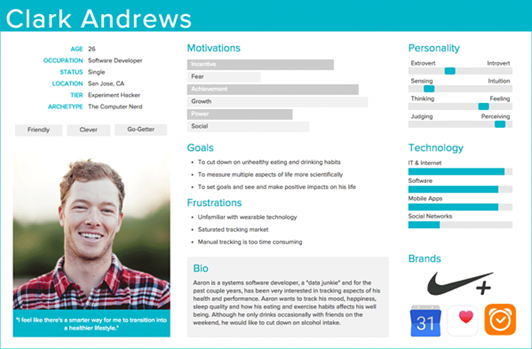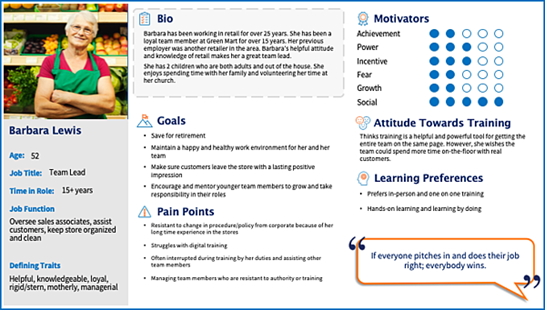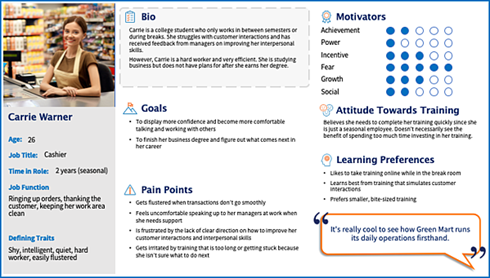ATD Blog
Using Learner Personas for Empathy-Driven Training
Wed Nov 18 2020

Think about what your learners are doing right now. Are they on the floor helping a customer? Are they going from meeting to meeting? What needs do they have during their day-to-day jobs? If you were to sit down with them for a cup of coffee, what kinds of experiences would they share?
Getting to know your learner and wanting to design the best training that you can for them is at the heart of a human-centered design practice called learner experience (LX) design. LX design focuses on developing empathy for your learners, understanding their needs, and creating a training experience that supports those needs.
But how do you go about getting to know your learners in a way that will best support their learning experience?
Taking a Lesson From Software Design
LX design pulls from the user experience research and design practices that have been used by successful product and software companies for years. They help user personas to identify different categories of their product users. A user persona is a made up “person” that serves as a representation for a general group of users that would be using that product. The user persona will typically include the persona’s background, age, skills, comfort with technology, and goals that the person may have for using that software product.

While designing the product, the design and development team will keep this persona in mind to help make sure that they are solving for the needs that their real users will have. It helps them more readily put themselves in the shoes of their user and ask questions like, “Would Clark be able to meet his goals with our product?”
Audience Analysis Through Learner Personas
Like software design, having a human-centered instructional design strategy can help us create better training. By creating learner personas, we can ensure that we are keeping our learners and their needs at the heart of all our decisions.
Like user personas, a learner persona includes background information, goals, and pain points as well as information more geared towards instructional design-like job functions, learning preferences, and attitudes.

The Benefits of Using Learner Personas
Prevent Self-Referential Design
Learner personas can help to identify the needs, goals, and challenges of our learners while ensuring that we are making decisions based off their perspectives instead of just our own. If every learner thought the same way that we did, our training would always hit the mark. Instead, we must consider the diversity of our audience.
For example, I may be a visual learner, so creating a diagram or animation would make sense to me as a way to teach a new process. But for Barbara, who learns best with hands-on activities, this strategy wouldn’t be as effective. Considering her needs can help me come up with better training strategies that will hit on a wider range of learning styles.
Create More Relevant Messaging
As much as we would love our learners to be enthusiastic about 100 percent of their training 100 percent of the time, most learners are thinking one thing when they sit down to do their training: “Why do I have to do this?” Learners are much more apt to engage in training and enact new practices if it is relevant to them.
Thinking through your learners’ attitudes toward training, their expectations, and motivations can help you to craft a message that conveys the importance of your training and excites your learners. For example, a seasonal employee like Carrie (below) may not understand the importance of her training since she isn’t a year-round associate. But stressing how the skills covered in the training are transferrable to other experiences or about how high performance could lead to advanced career opportunities within the company could lead to Carrie being more engaged in her training.

Design With Empathy
It’s easy for us to just think of our learners in terms of generalizations and statistics, but there’s more to them than just their ages or job codes. Designing with empathy means connecting with our learners, understanding their needs, and creating better learning experiences for them. That’s where creating a realistic persona has real power.
So, go beyond the basics and include details like education, job experiences, motivations, the names of pets, and so forth. We even recommend including stock photos in your personas.
These details may seem superfluous at first, but they’re critical to bringing your personas to life. Flushed out personas feel like real people, and using them to guide your design process will make it easier for you to step into your learner’s shoes. By empathizing and relating to your learners, your team will have a stronger connection and understanding of them, and you’ll find yourselves with an even stronger motivation to make your training the best that it can be.
Where Do I Get This Information?
The best and most accurate personas embody audience data and analysis. This data could come from in-person interviews with learners or online surveys that ask learners about their learning styles, experiences on the job, and what kinds of support they need for different training topics. But when it's not possible to talk with your learners directly, don't fret.
Talk with subject matter experts or managers about their experiences and the stories they've heard from the field. Ask them what daily challenges your learners face in their job and what feedback they’ve heard about current training practices. Your LMS administrators may have additional training information from your learners including demographics, previous training performances, and other trends.
When used correctly, learner personas are a powerful way to bring human-centered design to your current development process. And they can lead to more effective and imaginative ways to create training! We recommend creating at least two to three personas for a project to ensure that you’re addressing multiple needs and evaluating your training through multiple perspectives.
Want to Learn More?
Join me at ATD TechKnowledge 2021 for the session, Designing From the Heart! Learner Empathy and the User Experience. We will explore how to develop learner personas to truly support you in your learner empathy journey.
Editor’s note: This post originally published on the Reflection Software blog.
